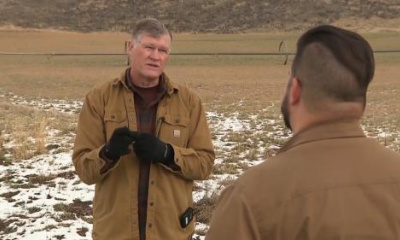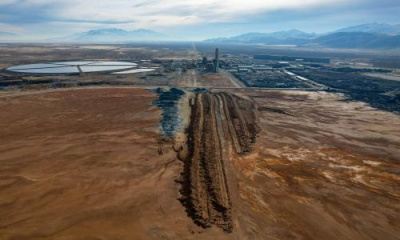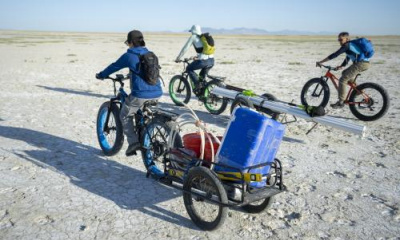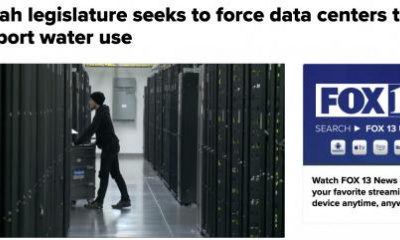SALT LAKE CITY — Joel Ferry reflected on a meaningful piece of advice his father gave him on the farm as he thought about the future of the struggling Great Salt Lake.
"My dad would always tell me, 'Make sure the water gets to the end of the row,'" said Ferry, director of the Utah Department of Natural Resources, referring to a common idiom farmers say to emphasize the importance that all crops are watered in an irrigation system to ensure a better yield.
When it comes to water policy, the Great Salt Lake is at the end of the row. It only grows with whatever is leftover after people pull water out of its tributaries for a wide range of vital reasons.
While agriculture, municipal, industrial and other water uses are important for the future of the state, Ferry believes the state must come together to find a way to save some for the lake. It means the Utah Legislature should continue to invest in tools to allow Utahns to be more efficient with their water consumption and conserve water, while also tracking any water saved to make sure it goes into the lake.
He adds a new report compiled by experts from higher education institutions and state agencies offers a new "hope" that it's possible.
The report, released by the Great Salt Lake Strike Team on Wednesday, offers new data and insights on how the lake can continue to make gains within the next three decades after it rose by a little more than 3 feet from its record 2022 low, following a record snowpack and summer evaporation period.
That is as long as lawmakers act quickly enough and address long-term solutions "immediately."
"We, as Utahns, can make a difference," said Ferry, one of the report's authors. "We can make a difference if we all work together and all do our part. We can save the Great Salt Lake."
Saving the lake is easier said than done, though. The group, composed of researchers at the University of Utah, Utah State University and the Utah Department of Natural Resources, warns "no single solution will cure the lake." They note trade-offs are necessary to balance "human, ecological and economic health."
Great Salt Lake Commissioner Brian Steed, also the director of USU's Janet Quinney Lawson Institute for Land, Water, and Air at Utah State University, adds it may be a "complicated effort" given all the various water needs and water rights within the Great Salt Lake Basin. He says this underscores the need for major planning and collaboration.
The new report comes a week before Utah is scheduled to release its proposed strategic plan for the lake, which will seek to guide Utah through these challenges.
What was learned in 2023
The strike team released its first report in February 2023, outlining possible solutions to help the lake. Its initial report pointed to agriculture optimization and water leasing as two of the more feasible options when considering impact and cost.
Of course, something outside of anyone's control drastically improved the lake.
The lake's southern arm had already gained about 1½ feet from its record-low by the time the first report was published, as winter storms pummeled the West. It rose another 4 feet by the end of the spring runoff, before dropping down another 2 feet due to evaporation. Its northern arm, which didn't receive as much water because of a berm at the causeway, experienced far less fluctuation over the past year.
The southern arm is now listed at 4,192.6 feet elevation, according to the U.S. Geological Survey. It's about 5½ feet below the lake's minimum healthy level of 4,198 feet, while its northern arm remains about 8½ feet under that goal.
"We are mindful of how much progress has been made and how much work remains," the team's leaders wrote in an adjoining letter.
The team's second report outlines some new findings from 2023's record year. For example, researchers found the lake likely could have gained even more water last year, but a decent amount of the snowpack water helped recharge groundwater reservoirs after years of drought.
Researchers can now track these invisible reservoirs, which should lead to more accurate runoff forecasts in the future, said Bill Anderegg, director of the Wilkes Center for Climate Science and Policy at the University of Utah. He explained last year's ability to refill underground water should also lead to a more efficient runoff this spring.
"This is a key piece of the hydrology that tells us how much water ends up in the streams, ends up available to society and ultimately ends up going into the lake," he said.
What happens next?
This year's report illustrates more about how much water needs to be saved to get the lake back to the minimum healthy range of 4,198 feet elevation over the next five, 10 and 30 years. "Significant water-use reductions" would have to be enacted in all three scenarios.
For instance, it would take about 1.1 to 1.7 million acre-feet of additional water annually to reach the optimal range of 4,198 feet elevation over the next five years, depending on drought conditions. It would take an additional 471,000 to 1.06 acre-feet of water every year to reach the goal in 30 years.
"That's a tall order, but it's not impossible," Steed said, noting it as one of the key findings this time around.
The report indicates researchers don't believe the lake will return to 4,198 feet elevation by 2054 without any sort of intervention, and the lake may continue to fall to even greater lows if drought conditions continue to ravage the region as they have over the past two decades.
They note water shepherding is needed in the future to make it happen. This is when any water saved, either through conservation or water donations, temporarily or permanently, flows into the lake. Members of the strike team say that will require efforts from all water users to save water and better techniques to track water consumption to know if any water saved for the lake goes to it.
It's ultimately up to Utah lawmakers to decide any course of action or timeline, which may be included in the forthcoming strategic plan.
While Ferry likens the future of the Great Salt Lake to farm irrigation, Anderegg views saving the lake more like a marathon because it will take many years to happen. He believes Utah is about 5 to 10 miles into it, with all that's been done so far and what's on the table in this scenario.
Anderegg also urges state leaders to invest in the tools now so Utah can complete the race.
"We can do this," he said. "The strike team has charted a path and we can restore the lake to healthy levels to the benefit of all Utahns."









